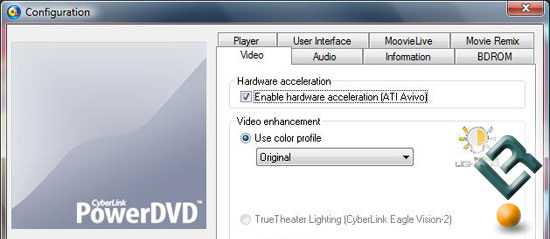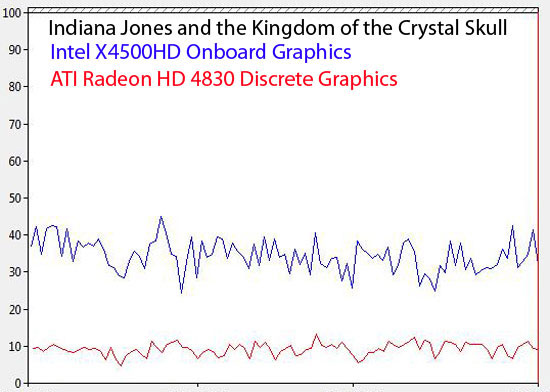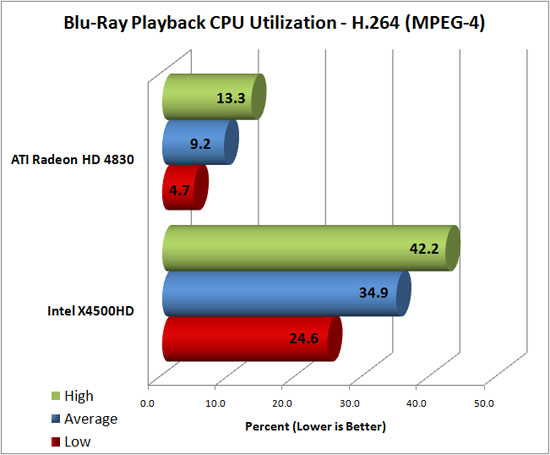Blu-Ray Performance – Intel X4500HD Versus Radeon HD 4830
CPU Utilization During Blu-Ray Playback

To test CPU Utilization during Blu-Ray playback I used PowerDVD 8 Ultra (build 2021.50) and enabled hardware acceleration within the application (as seen above). It should be noted that Hardware acceleration could only be enabled on the system with the ATI Radeon HD 4830 installed as the feature is not available with integrated graphics (Hear Kyle from [H]ard|OCP talk about this issue here). CPU utilization was logged for 90 seconds of playback with each movie, and the results were taken. Movies were played back in full screen mode with the desktop resolution set to 1920×1080, or 1080p.

The first movie to be tested was Indiana Jones and the Kingdom of the Crystal Skull. This title is MPEG-4 (H.264) and has Dobly True HD 5.1 handling the audio side of things. The above chart shows CPU Utilization over the 90 second test period in order to give you a better idea of what the CPU is up to during Blu-Ray movie playback.

Once we enter all the data points into Microsoft Excel we can find the average CPU Utilization along with the high and low points during the playback test. As you can see the Intel DG45ID motherboard with X4500HD onboard graphics needed to use the CPU more during playback as it averaged 35% CPU usage to play the movie. With the Radeon HD 4830 graphics card installed in the system the average CPU usage lowered to just 9%, which is a 74% reduction in CPU usage.

Many Blu-Ray movies use VC-1 and Shoot ‘Em Up just happens to be one of those titles and it has DTS-HD MasterAudio 7.1 for audio. The Intel DG45ID motherboard with X4500HD onboard graphics did a little better here, but was still at 29% CPU usage. The ATI Radeon HD 4830 graphics card had on average 11% CPU usage, which is 62% less than the integrated graphics.
Update: Shortly after Legit Reviews published our Radeon HD 4830 articles we were notified by AMD that every reference card they sent out to reviews came with an incorrect BIOS. The BIOS that shipped on the Radeon HD 4830 had one too many of the SIMDS disabled and that the Radeon HD 4830 had just 560 stream processors enabled instead of the 640 stream processors that it should have been running. Read this article to see what the right BIOS does for performance!
Final Thoughts and Conclusions:
When it comes to Blu-Ray playback it is clear that discrete graphics cards like the Radeon HD 4830 are the way to go as they offer 62% to 74% less CPU usage and the playback is smooth as silk. The Intel DG45ID motherboard with X4500HD onboard graphics did very well and only in certain movies with panning wide angle shots would you catch a stutter or two that are smooth when using discrete graphics. An example of this is the H.264 title Iron Man during the hostage scene where the camera is pulling back from a close up of Tony Stark tied to a chair with terrorists around him. When the camera pulls out you can tell that it’s not smooth and little things like that can ruin a Blu-Ray movie, but I only caught that when using the system for a few days with each graphics solution. Integrated graphics are coming close to perfect Blu-Ray playback, but with dual-decode (PiP) and other features becoming popular the best way to go is still discrete.
Legit Bottom Line: The Radeon HD 4830 graphics card used roughly 70% less CPU usage during Blu-Ray playback when compared to integrated graphics solutions like the Intel X4500HD.

Comments are closed.